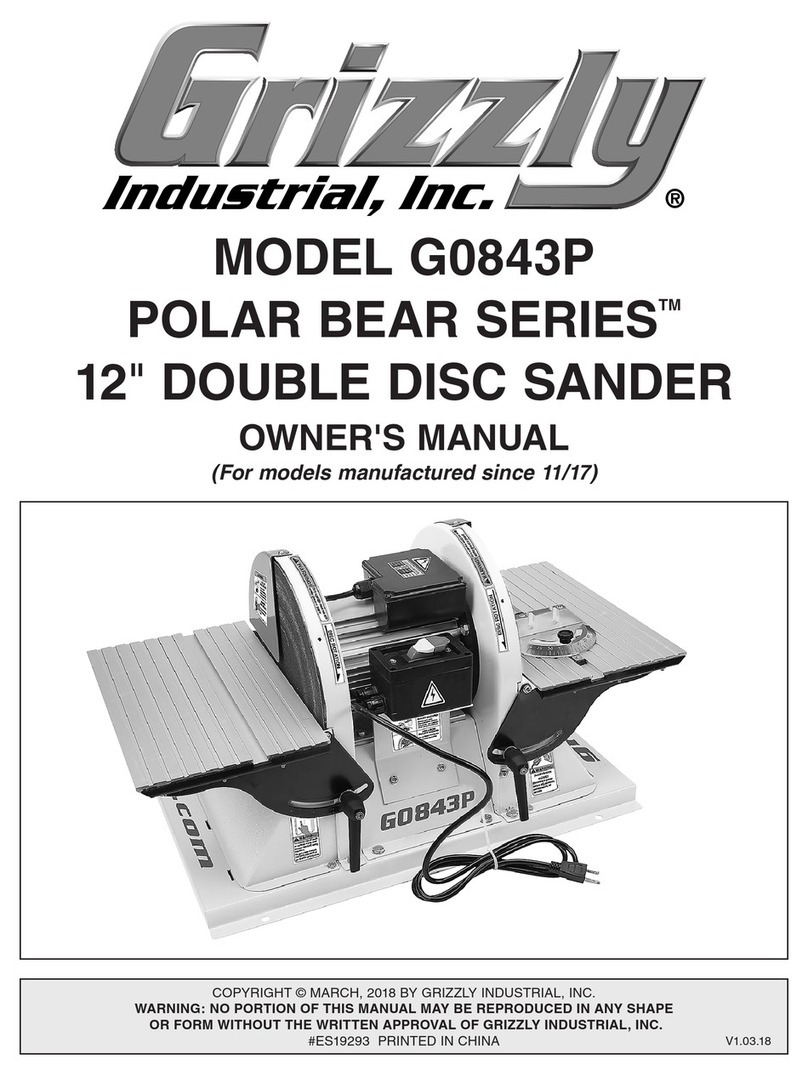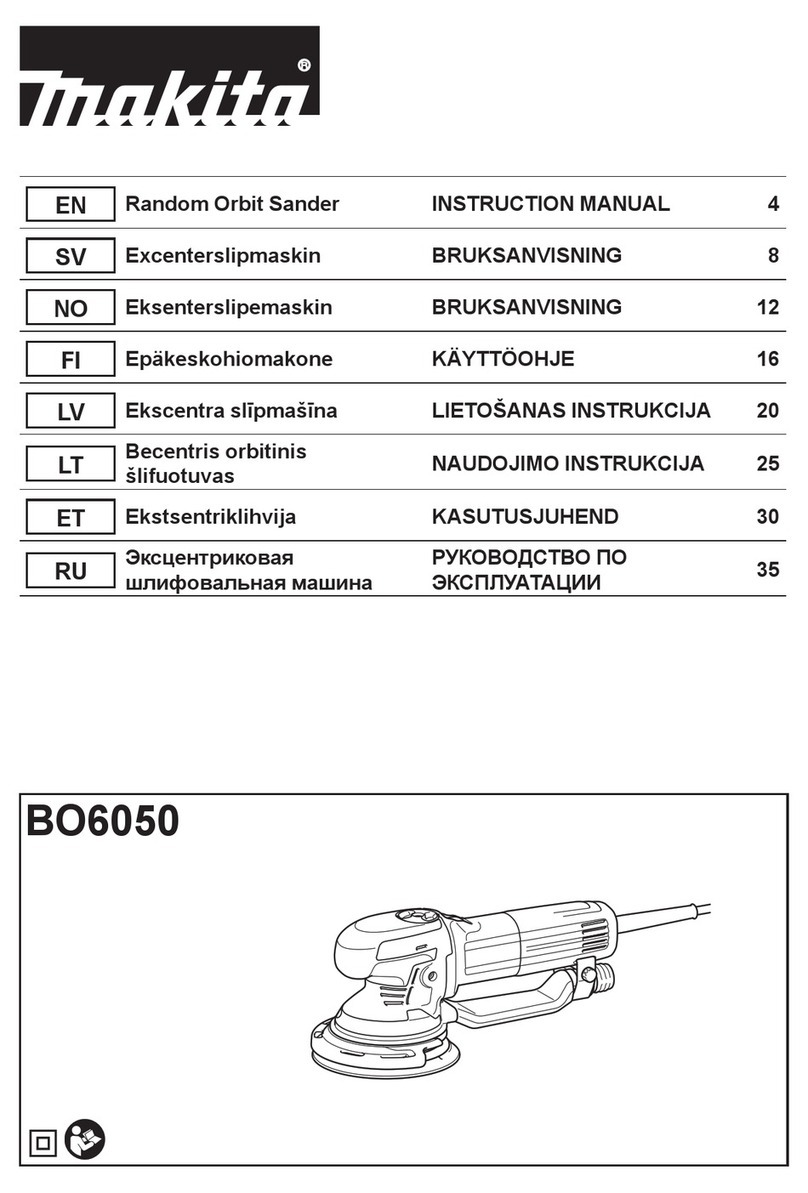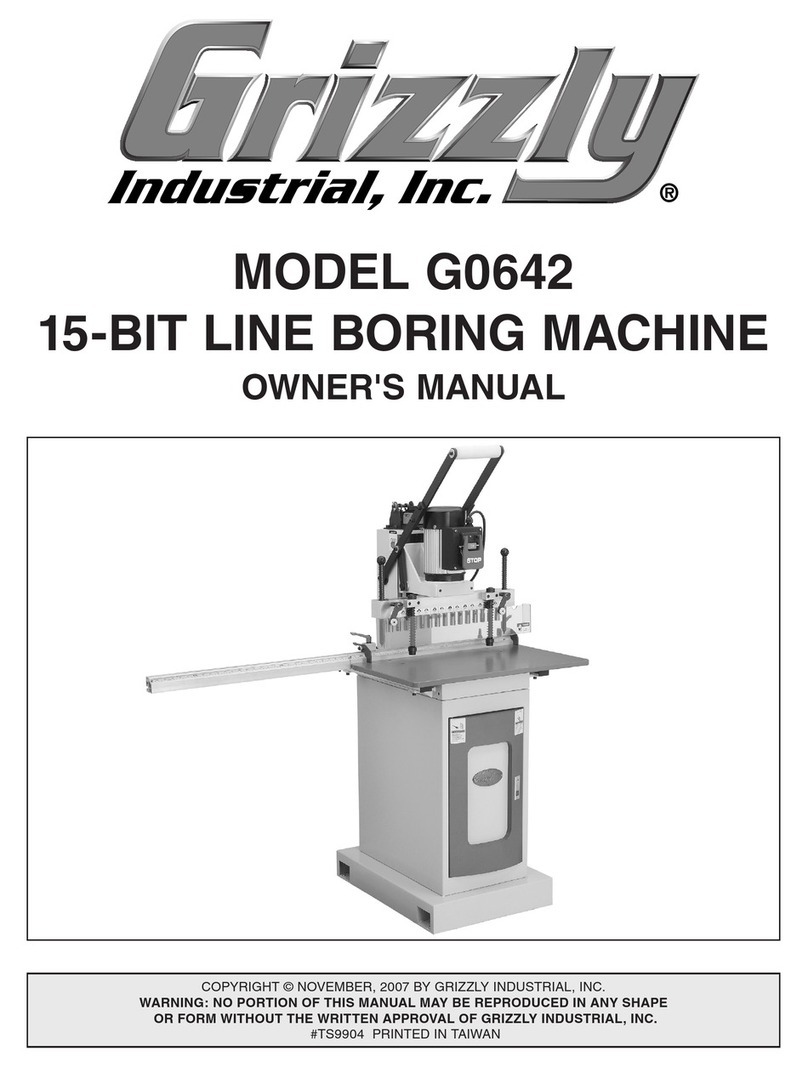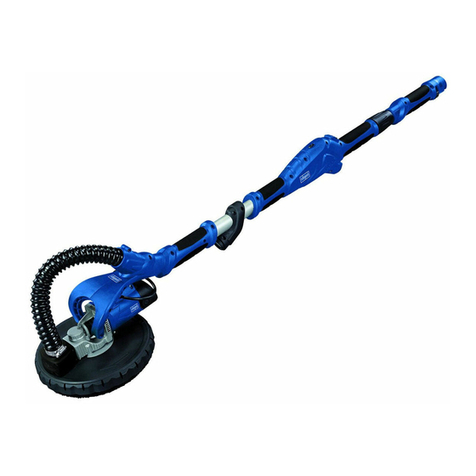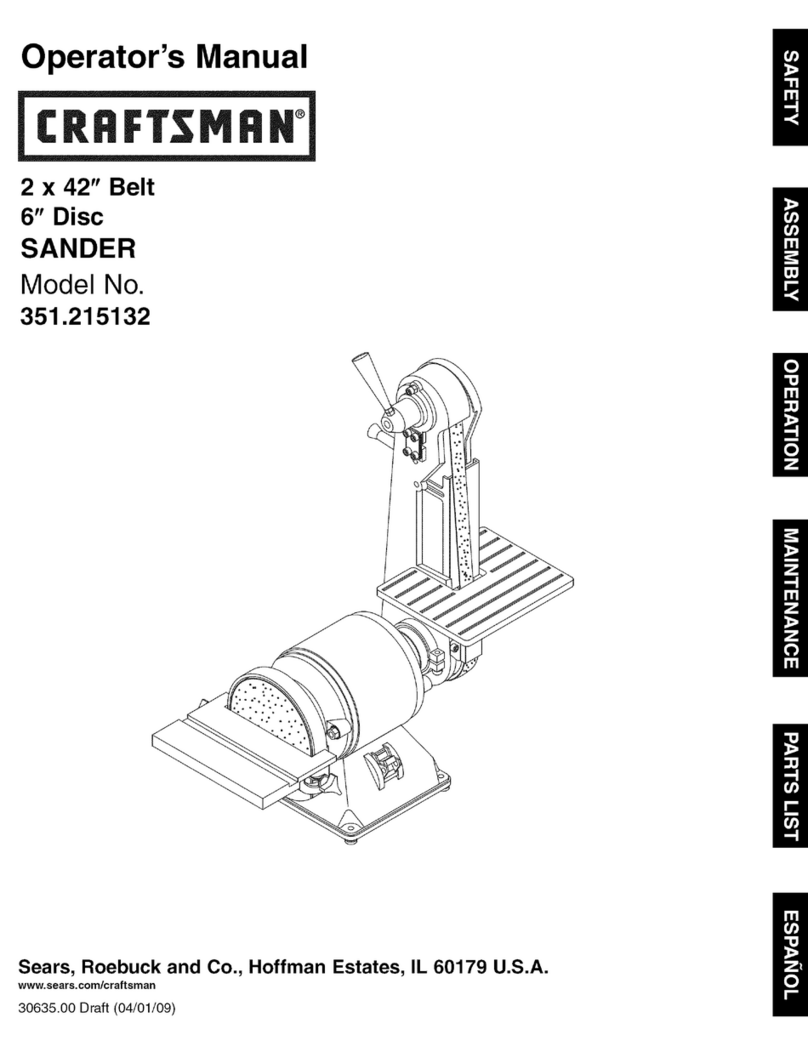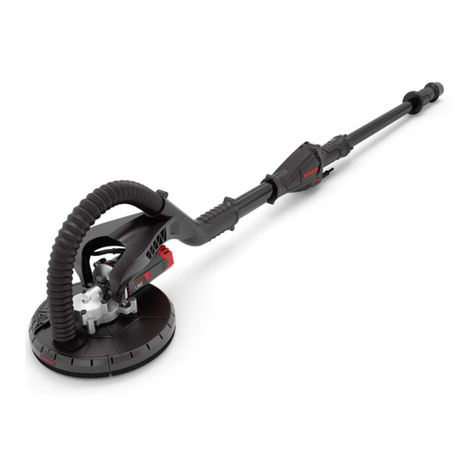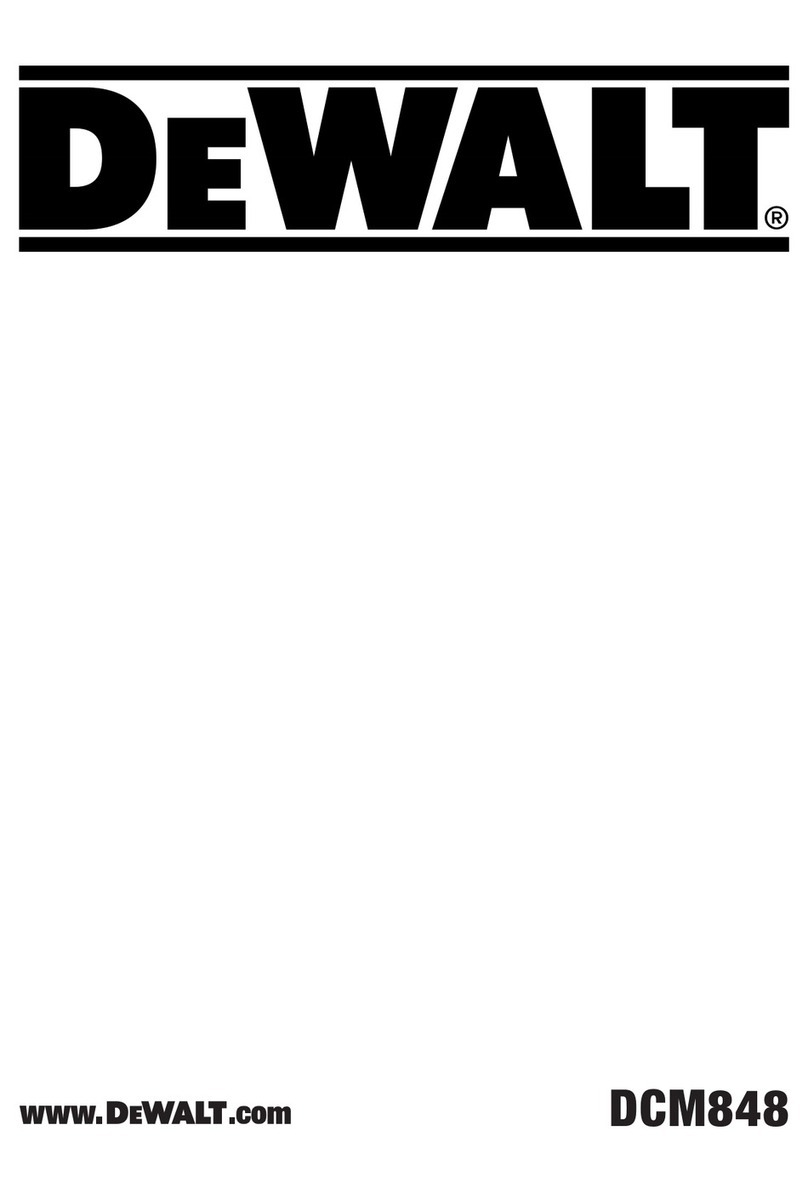South Bend Tools SB1102 User manual

®
A Tradition of Excellence
South Bend Tools
© November, 2021 by South Bend Tools For Machines Mfd. Since 12/21
MODEL SB1102
26" 5 HP Drum Sander
OWNER'S MANUAL

Customer Service
We stand behind our machines. If you have any service questions, parts requests or general questions
about your purchase, feel free to contact us.
South Bend Tools
P.O. Box 2027
Bellingham, WA 98227
Phone: (360) 734-1540
Fax: (360) 676-1075 (International)
Fax: (360) 734-1639 (USA Only)
Email: [email protected]
Updates
For your convenience, any updates to this manual will be available to download free of charge
through our website at:
www.southbendtools.com
Scope of Manual
This manual helps the reader understand the machine, how to prepare it for operation, how to control
it during operation, and how to keep it in good working condition. We assume the reader has a basic
understanding of how to operate this type of machine, but that the reader is not familiar with the
controls and adjustments of this specific model. As with all machinery of this nature, learning the
nuances of operation is a process that happens through training and experience. If you are not an
experienced operator of this type of machinery, read through this entire manual, then learn more
from an experienced operator, schooling, or research before attempting operations. Following this
advice will help you avoid serious personal injury and get the best results from your work.
Manual Feedback
We've made every effort to be accurate when documenting this machine. However, errors sometimes
happen or the machine design changes after the documentation process—so
the manual may not
exactly match your machine.
If a difference between the manual and machine leaves you in doubt,
contact our
customer service for clarification.
We highly value customer feedback on our manuals. If you have a moment, please share your
experience using this manual. What did you like about it? Is there anything you would change to
make it better? Did it meet your expectations for clarity, professionalism, and ease-of-use?
South Bend Tools
C
/O Technical Documentation Manager

Table of Contents
ACCESSORIES.............................................................. 26
MAINTENANCE ............................................................. 27
Maintenance Schedule....................................... 27
Machine Storage ................................................27
Cleaning & Protecting .......................................28
Lubrication......................................................... 28
SERVICE...........................................................................30
Aligning Drums..................................................30
Adjusting Pressure Rollers................................ 34
Adjusting Conveyor Belt Tension & Tracking .35
Adjusting Dust Scoop.........................................36
Adjusting/Replacing V-Belts .............................37
Replacing Bearings ............................................39
Replacing Conveyor Motor Brushes..................40
TROUBLESHOOTING................................................. 41
ELECTRICAL................................................................... 45
Electrical Safety Instructions ...........................45
Wiring Diagram .................................................46
Electrical Component Photos ............................ 47
PARTS................................................................................48
Stand & Motor....................................................48
Conveyor Table ..................................................50
Drums & Rollers ................................................ 52
Control Panel & Handwheel .............................54
Electrical Components.......................................55
Machine Labels ..................................................56
WARRANTY..................................................................... 57
INTRODUCTION...............................................................2
Identification ........................................................2
Description of Controls & Components ..............3
Product Specifications ......................................... 4
SAFETY................................................................................6
Understanding Risks of Machinery ....................6
Basic Machine Safety .......................................... 6
Additional Drum Sander Safety..........................8
PREPARATION .................................................................9
Preparation Overview.......................................... 9
Required for Setup............................................... 9
Power Supply Requirements.............................10
Unpacking ..........................................................12
Inventory ............................................................12
Location ..............................................................13
Lifting & Placing................................................14
Assembly ............................................................14
Dust Collection................................................... 15
Test Run .............................................................16
Inspections & Adjustments ...............................17
OPERATION.................................................................... 18
Operation Overview........................................... 18
Stock Inspection & Requirements.....................19
Choosing Sandpaper ..........................................19
Sanding Tips ......................................................20
Sanding............................................................... 21
Setting Depth of Cut.......................................... 21
Setting Conveyor Speed..................................... 22
Monitoring Sanding Load.................................. 22
Installing/Replacing Sandpaper........................ 23
Cleaning Sandpaper ..........................................25

-2-
For Machines Mfd. Since 12/21
South Bend Tools
Model SB1102 INTRODUCTION
Identification
Serious personal injury could occur if
you connect the machine to power before
completing the setup process. DO NOT
connect power until instructed to do so later
in this manual.
Untrained users have an increased risk
of seriously injuring themselves with this
machine. Do not operate this machine until
you have understood this entire manual and
received proper training.
Control PanelControl Panel
4" Dust Ports4" Dust Ports
Table HeightTable Height
HandwheelHandwheel
Rear Sanding DrumRear Sanding Drum
Micro-Adjustment KnobMicro-Adjustment Knob
Front SandingFront Sanding
DrumDrum
Rear SandingRear Sanding
DrumDrum
ConveyorConveyor

South Bend Tools
For Machines Mfd. Since 12/21 Model SB1102
-3-
INTRODUCTION
Description of Controls
& Components
Refer to Figures 1–3and the following
descriptions to become familiar with the basic
controls and components used to operate this
machine. Understanding these items and how
they work will help you understand the rest of
the manual and stay safe when operating this
machine.
H. Conveyor Table w/Belt: Adjusts up and down
and has conveyor belt that feeds workpieces
under sanding drums.
I. Table Height Handwheel: Rotates to raise or
lower conveyor table according to workpiece
thickness.
J. Rear Sanding Drum Micro-Adjustment Knob:
Rotates to make fine adjustments to rear
sanding drum.
K. Micro-Adjustment Lock Lever: Locks rear
sanding drum micro-adjustment knob in
place.
L. Depth-of-Cut Scale: Indicates distance
between conveyor table and sanding drums.
Sanding Controls
FigureFigure 2. Sanding Controls.. Sanding Controls.
HHJJ
IIKK
LL
Sanding Drums
FigureFigure 3. Sanding drums.Sanding drums.
MM
M. Sanding Drums: Rotate against incoming
workpiece to achieve flat, smooth surface.
Control Panel
A. Sanding Load Display: Displays current amp
draw of sanding motor. Buttons on display
have no function for this machine.
B. Emergency Stop Button: Stops motors when
pressed and disables ON buttons.
C. Conveyor Speed Control Dial: Rotates to
adjust conveyor belt speed between 0–20 FPM.
D. Sanding Drum Motor ON Button: Turns
sanding motor ON. Illuminates when
pressed.
E. Sanding Drum Motor OFF Button: Turns
sanding motor OFF. Illuminates when
pressed.
F. Conveyor Motor ON Button: Turns conveyor
motor ON. Illuminates when pressed.
G. Conveyor Motor OFF Button: Turns conveyor
motor OFF. Illuminates when pressed.
FigureFigure 1. Control Panel.
BBCC
AA
DD
EE
FF
GG

-4-
For Machines Mfd. Since 12/21
South Bend Tools
Model SB1102 INTRODUCTION
Product Specifications
Model SB1102 Page 1 of 2
Model SB1102
26" 5 HP Single‐Phase Drum Sander
Product Dimensions
Weight............................................................................................................................................................. 443 lbs.
Width (side-to-side) x Depth (front-to-back) x Height......................................................... 50-1/2 x 36-1/2 x 57 in.
Footprint (Length x Width)................................................................................................................. 23-1/2 x 27 in.
Shipping Dimensions
Type.......................................................................................................................................................... Wood Crate
Content.......................................................................................................................................................... Machine
Weight............................................................................................................................................................. 498 lbs.
Length x Width x Height................................................................................................................... 52 x 41 x 47 in.
Must Ship Upright................................................................................................................................................ Yes
Electrical
Power Requirement......................................................................................................... 220V, Single-Phase, 60 Hz
Full-Load Current Rating.................................................................................................................................... 27A
Minimum Circuit Size.......................................................................................................................................... 30A
Connection Type..................................................................................................................................... Cord & Plug
Power Cord Included............................................................................................................................................. Yes
Power Cord Length............................................................................................................................................ 70 in.
Power Cord Gauge......................................................................................................................................... 10 AWG
Plug Included........................................................................................................................................................ Yes
Included Plug Type............................................................................................................................................ L6-30
Switch Type....................................................................................... Control Panel w/Magnetic Switch Protection
Motors
Main
Horsepower............................................................................................................................................... 5 HP
Phase............................................................................................................................................ Single-Phase
Amps........................................................................................................................................................... 25A
Speed................................................................................................................................................ 3450 RPM
Type............................................................................................................. TEFC Capacitor-Start Induction
Power Transfer .......................................................................................................................................... Belt
Bearings.................................................................................................... Sealed & Permanently Lubricated
Centrifugal Switch/Contacts Type..................................................................................................... External
Conveyor
Horsepower............................................................................................................................................ 1/3 HP
Phase............................................................................................................................................ Single-Phase
Amps............................................................................................................................................................. 2A
Speed.................................................................................................................................................... 60 RPM
Type................................................................................................................................................... Universal
Power Transfer ....................................................................................................................................... Chain
Bearings.................................................................................................... Sealed & Permanently Lubricated
DATA SHEET

South Bend Tools
For Machines Mfd. Since 12/21 Model SB1102
-5-
INTRODUCTION
Model SB1102 Page 2 of 2
Main Specifications
Operation Information
Number of Sanding Heads.............................................................................................................................. 2
Maximum Board Width........................................................................................................................... 26 in.
Minimum Board Width............................................................................................................................. 2 in.
Maximum Board Thickness...................................................................................................................... 4 in.
Minimum Board Thickness.................................................................................................................... 1/8 in.
Minimum Board Length............................................................................................................................ 9 in.
Sandpaper Speed............................................................................................................................. 2300 FPM
Conveyor Feed Rate........................................................................................................................ 0 - 20 FPM
Sandpaper Length................................................................................................................................. 195 in.
Sandpaper Width....................................................................................................................................... 3 in.
Drum Information
Infeed Sanding Drum Type............................................................................................................ Aluminum
Infeed Sanding Drum Size........................................................................................................................ 6 in.
Outfeed Sanding Drum Type.......................................................................................................... Aluminum
Outfeed Sanding Drum Size...................................................................................................................... 6 in.
Construction
Conveyor Belt........................................................................................................................................ Rubber
Body........................................................................................................................................................... Steel
Paint Type/Finish.................................................................................................................... Powder Coated
Other Related Information
Floor To Table Height.......................................................................................................... 28-1/8 - 32-1/8 in.
Sanding Belt Tension.................................................................................................................. Hook & Loop
Number of Pressure Rollers........................................................................................................................... 3
Pressure Roller Type............................................................................................................................ Rubber
Pressure Roller Size............................................................................................................................ 1-5/8 in.
Conveyor Belt Length.............................................................................................................................. 74 in.
Conveyor Belt Width............................................................................................................................... 26 in.
Belt Roller Size.................................................................................................................................... 1-7/8 in.
Number of Dust Ports..................................................................................................................................... 2
Dust Port Size............................................................................................................................................ 4 in.
Other
Country of Origin ........................................................................................................................................... Taiwan
Warranty ........................................................................................................................................................ 2 Years
Approximate Assembly & Setup Time ................................................................................................... 30 Minutes
Serial Number Location .............................................................................................................................. ID Label
Features
Hook & Loop Sanding Belt Tension/Sandpaper
Industrial-Duty Rubber Conveyor Belt
Two 4" Dust Ports
Variable-Speed Conveyor
Dual 6" Aluminum Sanding Drums
Four Leadscrew Table Lift System
Easy Access Control Panel with Amp Load Meter
External Micro-Adjustment on Outfeed Drum

SAFETY
-6-
For Machines Mfd. Since 12/21
South Bend Tools
Model SB1102 SAFETY
Understanding Risks of Machinery
Operating all machinery and machining equipment can be dangerous or relatively safe depending
on how it is installed and maintained, and the operator's experience, common sense, risk awareness,
working conditions, and use of personal protective equipment (safety glasses, respirators, etc.).
The owner of this machinery or equipment is ultimately responsible for its safe use. This
responsibility includes proper installation in a safe environment, personnel training and usage
authorization, regular inspection and maintenance, manual availability and comprehension,
application of safety devices, integrity of cutting tools or accessories, and the usage of approved
personal protective equipment by all operators and bystanders.
The manufacturer of this machinery or equipment will not be held liable for injury or property
damage from negligence, improper training, machine modifications, or misuse. Failure to read,
understand, and follow the manual and safety labels may result in serious personal injury, including
amputation, broken bones, electrocution, or death.
The signals used in this manual to identify hazard levels are as follows:
Death or catastrophic
harm WILL occur.
Moderate injury or fire
MAY occur.
Death or catastrophic
harm COULD occur.
Machine or property
damage may occur.
Basic Machine Safety
Owner’s Manual: All machinery and machining
equipment presents serious injury hazards
to untrained users. To reduce the risk of
injury, anyone who uses THIS item MUST
read and understand this entire manual
before starting.
Personal Protective Equipment: Operating or
servicing this item may expose the user
to flying debris, dust, smoke, dangerous
chemicals, or loud noises. These hazards
can result in eye injury, blindness, long-
term respiratory damage, poisoning,
cancer, reproductive harm or hearing loss.
Reduce your risks from these hazards
by wearing approved eye protection,
respirator, gloves, or hearing protection.
Trained/Supervised Operators Only: Untrained
users can seriously injure themselves
or bystanders. Only allow trained and
properly supervised personnel to operate
this item. Make sure safe operation
instructions are clearly understood. If
electrically powered, use padlocks and
master switches, and remove start switch
keys to prevent unauthorized use or
accidental starting.
Guards/Covers: Accidental contact with
moving parts during operation may cause
severe entanglement, impact, cutting,
or crushing injuries. Reduce this risk by
keeping any included guards/covers/doors
installed, fully functional, and positioned
for maximum protection.

South Bend Tools
For Machines Mfd. Since 12/21 Model SB1102
-7-
SAFETY
Entanglement: Loose clothing, gloves, neckties,
jewelry or long hair may get caught in
moving parts, causing entanglement,
amputation, crushing, or strangulation.
Reduce this risk by removing/securing
these items so they cannot contact moving
parts.
Mental Alertness: Operating this item with
reduced mental alertness increases the
risk of accidental injury. Do not let a
temporary influence or distraction lead to a
permanent disability! Never operate when
under the influence of drugs/alcohol, when
tired, or otherwise distracted.
Safe Environment: Operating electrically
powered equipment in a wet environment
may result in electrocution; operating near
highly flammable materials may result in a
fire or explosion. Only operate this item in
a dry location that is free from flammable
materials.
Electrical Connection: With electically powered
equipment, improper connections to the
power source may result in electrocution
or fire. Always adhere to all electrical
requirements and applicable codes when
connecting to the power source. Have all
work inspected by a qualified electrician to
minimize risk.
Disconnect Power: Adjusting or servicing
electrically powered equipment while it
is connected to the power source greatly
increases the risk of injury from accidental
startup. Always disconnect power
BEFORE any service or adjustments,
including changing blades or other tooling.
Secure Workpiece/Tooling: Loose workpieces,
cutting tools, or rotating spindles can
become dangerous projectiles if not
secured or if they hit another object during
operation. Reduce the risk of this hazard
by verifying that all fastening devices are
properly secured and items attached to
spindles have enough clearance to safely
rotate.
Chuck Keys or Adjusting Tools: Tools used to
adjust spindles, chucks, or any moving/
rotating parts will become dangerous
projectiles if left in place when the machine
is started. Reduce this risk by developing
the habit of always removing these tools
immediately after using them.
Work Area: Clutter and dark shadows increase
the risks of accidental injury. Only operate
this item in a clean, non-glaring, and well-
lighted work area.
Properly Functioning Equipment: Poorly
maintained, damaged, or malfunctioning
equipment has higher risks of causing
serious personal injury compared to
those that are properly maintained.
To reduce this risk, always maintain
this item to the highest standards and
promptly repair/service a damaged or
malfunctioning component. Always follow
the maintenance instructions included in
this documentation.
Unattended Operation: Electrically powered
equipment that is left unattended while
running cannot be controlled and is
dangerous to bystanders. Always turn the
power OFF before walking away.
Health Hazards: Certain cutting fluids and
lubricants, or dust/smoke created when
cutting, may contain chemicals known to
the State of California to cause cancer,
respiratory problems, birth defects,
or other reproductive harm. Minimize
exposure to these chemicals by wearing
approved personal protective equipment
and operating in a well ventilated area.
Difficult Operations: Attempting difficult
operations with which you are unfamiliar
increases the risk of injury. If you
experience difficulties performing the
intended operation, STOP! Seek an
alternative method to accomplish the
same task, ask a qualified expert how the
operation should be performed, or contact
our Technical Support for assistance.

-8-
For Machines Mfd. Since 12/21
South Bend Tools
Model SB1102 SAFETY
Additional Drum Sander Safety
Serious injury or death can occur from getting hands trapped between workpiece and conveyor table
and being pulled into machine, or becoming entangled in rotating parts inside machine. Workpieces
thrown by sander can strike nearby operator or bystanders with significant force. Long-term
respiratory damage can occur from using sander without proper use of a respirator. To reduce the risk
of these hazards, operator and bystanders MUST completely heed the hazards and warnings below.
Avoiding Entanglement: Tie back long hair,
remove jewelry, and do not wear loose
clothing or gloves. These can easily get
caught in moving parts. Never reach
inside machine or try to clear jammed
workpiece while machine is operating.
Keep all guards in place and secure.
Workpiece Material: This sander is designed to
sand only natural wood products or man-
made products made from natural wood
fiber. DO NOT sand any metal products.
Workpiece Inspection: Nails, staples, knots,
or other imperfections in workpiece can
be dislodged and thrown from sander
at high rate of speed into operator or
bystanders, or cause damage to sandpaper
or sander. Never try to sand stock that has
embedded foreign objects or questionable
imperfections.
Kickback: Occurs when a workpiece is ejected
out the front of sander at a high rate of
speed toward operator or bystanders. To
reduce risk of kickback-related injuries,
always stay out of workpiece path, only
feed one board at a time, and always
make sure pressure rollers are properly
adjusted below sanding roller. Never sand
workpieces below minimum specifications
listed in Machine Data Sheet.
Feeding Workpiece:
Placing fingers between
workpiece and conveyor can result in
pinching injuries, or possibly getting
trapped and pulled into sanding area of
machine. DO NOT place fingers under
bottom of workpiece while feeding it into
sander.
Sanding Dust:
Sanding creates large amounts of
fine airborne dust that can lead to eye injury
or serious respiratory illness. Reduce your
risk by always wearing approved eye and
respiratory protection when sanding. Never
operate without adequate dust collection
system in place and running. However, dust
collection is not a substitute for using a
respirator.
Power Disconnect:
An accidental startup while
changing sanding belts or performing
adjustments or maintenance can result
in serious entanglement or abrasion
injuries. Make sure machine is turned
OFF, disconnected from power and air, and
all moving parts are completely stopped
before changing belts, doing adjustments, or
performing maintenance.
Sandpaper Contact:
Rotating sandpaper can
remove a large amount of flesh quickly.
Keep hands away from rotating sanding
drum(s) during operation. Never touch
moving sandpaper.
No list of safety guidelines can be complete. Every shop environment is different. Always consider
safety first, as it applies to your individual working conditions. Use this and other machinery with
caution and respect. Failure to do so may result in serious personal injury or property damage.

PREPARATION
South Bend Tools
For Machines Mfd. Since 12/21 Model SB1102
-9-
PREPARATION
Preparation Overview Required for Setup
For Assembly
• Additional Person for Moving
• Safety Glasses (for each person)
• Phillips Screwdriver #2
• Wrench or Socket 9⁄16"
• Hex Wrench 5mm
• Open-Ended Wrench 12mm
• Double-Sided Tape 1⁄16"
• Dust-Collection System
• 4" Dust Hoses (length as needed)
• 4" Hose Clamps
• 4" Y Adapter
The purpose of the preparation section is to help
you prepare your machine for operation. The list
below outlines the basic process. Specific steps
for each of these points will be covered in detail
later in this section.
The typical preparation process is as follows:
1. Unpack the machine and inventory the
contents of the box/crate.
2. Clean the machine and its components.
3. Identify an acceptable location for the
machine and move it to that location.
4. Level the machine and either bolt it to the
floor or place it on mounts.
5. Assemble the loose components and make
any necessary adjustments or inspections to
ensure the machine is ready for operation.
6. Connect the machine to the power source.
7. Test run the machine to make sure it
functions properly and is ready for operation.
The following items are needed, but not included
for the setup/assembly of this machine.
For Power Connection
• A power supply that meets the minimum
circuit requirements for this machine. (Refer
to the Power Supply Requirements
section for details.)
Like all machinery there is potential danger
when operating this machine. Accidents are
frequently caused by lack of familiarity or
failure to pay attention. Use this machine with
respect and caution to decrease the risk of
operator injury. If normal safety precautions are
overlooked or ignored, serious personal injury
may occur.
For Lifting
• Forklift (Min. 750 lb. rating)

-10-
For Machines Mfd. Since 12/21
South Bend Tools
Model SB1102 PREPARATION
Power Supply
Power Supply
Requirements
Electrocution or fire may
occur if machine is not
correctly grounded and
attached to the power
supply. Use a qualified
electrician to ensure a safe
power connection.
Before installing the machine, consider the
availability and proximity of the required power
supply circuit. If an existing circuit does not meet
the requirements for this machine, a new circuit
must be installed.
To minimize the risk of electrocution, fire,
or equipment damage, installation work and
electrical wiring must be done by a
n electrician
or qualified service personnel
in accordance with
applicable electrical codes and safety standards.
Availability
The full-load current rating is the amperage
a machine draws at 100% of the rated output
power. On machines with multiple motors, this is
the amperage drawn by the largest motor or sum
of all motors and electrical devices that might
operate at one time during normal operations.
The full-load current is not the maximum
amount of amps that the machine will draw. If
the machine is overloaded, it will draw additional
amps beyond the full-load rating.
If the machine is overloaded for a sufficient
length of time, damage, overheating, or fire may
result—especially if connected to an undersized
circuit. To reduce the risk of these hazards,
avoid overloading the machine during operation
and make sure it is connected to a power supply
circuit that meets the requirements in the
following section.
Full-Load Current Rating
Full-Load Rating at 220V................... 27 Amps
Circuit Requirements
This machine is prewired to operate on a power
supply circuit that has a verified ground and
meets the following requirements:
Note: The circuit requirements in this manual
are for
a dedicated circuit—where only one
machine will be running at a time. If this
machine will be connected to a shared circuit
where multiple machines will be running at
the same time, consult a qualified electrician to
ensure the circuit is properly sized.
A power supply circuit includes all electrical
equipment between the main breaker box or fuse
panel in your building and the incoming power
connections inside the machine. This circuit
must be safely sized to handle the full-load
current that may be drawn from the machine for
an extended period of time. (If this machine is
connected to a circuit protected by fuses, use a
time delay fuse marked D.)
Nominal Voltage ........ 208V, 220V, 230V, 240V
Cycle .............................................................60 Hz
Phase ..............................................Single-Phase
Circuit Rating....................................... 30 Amps
Plug/Receptacle ............................NEMA L6-30
Serious injury could occur if you connect
the machine to power before completing the
setup process. DO NOT connect to power until
instructed later in this manual.
For your own safety and protection of property,
consult an electrician if you are unsure about
wiring practices or applicable electrical codes.

South Bend Tools
For Machines Mfd. Since 12/21 Model SB1102
-11-
PREPARATION
Grounding Requirements
This machine must be grounded! In the event
of
certain types of malfunctions or breakdowns,
grounding provides a path of least resistance
for electric current
in order to reduce the risk of
electric shock.
This machine is equipped with a power cord
that has
an equipment-grounding wire and a
grounding plug
(similar to the figure below).
The plug
must only be inserted into a matching
receptacle (outlet)
that is properly installed and
grounded in accordance with all local codes and
ordinances.
Improper connection of the equipment-grounding
wire can result in a risk of electric shock. The
wire with green insulation (with or without
yellow stripes) is the equipment-grounding wire.
If repair or replacement of the power cord or
plug is necessary, do not connect the equipment-
grounding wire to a live (current carrying)
terminal.
Check with an electrician or qualified service
personnel if you do not understand these
grounding requirements, or if you are in doubt
about whether the tool is properly grounded.
If you ever notice that a cord or plug is
damaged or worn, disconnect it from power, and
immediately replace it with a new one.
Extension Cords
Minimum Gauge Size............................10 AWG
Maximum Length (Shorter is Better) ....50 ft.
We do not recommend using an extension cord
with this machine. If you must use one, only
use it if absolutely necessary and only on a
temporary basis.
Extension cords cause voltage drop, which may
damage electrical components and shorten motor
life. Voltage drop increases as the extension cord
size gets longer and the gauge size gets smaller
(higher gauge numbers indicate smaller sizes).
Any extension cord used with this machine
must contain a ground wire, match the required
plug and receptacle listed in the
Circuit
Requirements
for the applicable voltage, and
meet the following requirements:
FigureFigure 4. NEMA L6-30 plug and receptacle.. NEMA L6-30 plug and receptacle.
Grounding Prong
is Hooked
Current Carrying Prongs
GROUNDED
L6-30 LOCKING
RECEPTACLE
L6-30
LOCKING
PLUG
No adapter should be used with plug. If
plug does not fit available receptacle, or if
machine must be reconnected for use on a
different type of circuit, reconnection must
be performed by an electrician or qualified
service personnel, and it must comply with all
local codes and ordinances.

-12-
For Machines Mfd. Since 12/21
South Bend Tools
Model SB1102 PREPARATION
Unpacking
This item was carefully packaged to prevent
damage during transport. If you discover any
damage, please immediately call Customer
Service at
(360) 734-1540 for advice. You may
need to file a freight claim, so save the containers
and all packing materials for possible inspection
by the carrier or its agent.
Inventory
The following is a list of items shipped with your
machine. Before beginning setup, lay these items
out and inventory them.
If any non-proprietary parts are missing (e.g. a
nut or a washer), we will gladly replace them; or
for the sake of expediency, replacements can be
obtained at your local hardware store.
Box 1 (Figures 5–6) Qty
A. Drum Sander.................................................. 1
B. Handwheel .....................................................1
C. 4" Dust Port (Flat) .........................................1
D. 4" Dust Port (Concave) ..................................1
E. Handwheel Handle ........................................1
F. Hex Bolts 3⁄8"-16 x 2" ......................................3
G. Flat Washers 3⁄8".............................................3
H. Tap Screws #8 x 1⁄2"........................................8
I. Flat Washers #8 .............................................8
J. Hex Wrench 3, 5mm ............................... 1 Ea.
K. Tension Tool ...................................................1
NOTICE
If you cannot find an item on this list, carefully
check around/inside the machine and
packaging materials. Often, these items get
lost in packaging materials while unpacking or
they are pre-installed at the factory.
FigureFigure 5. Drum sander.Drum sander.
AA
Figure 6. Loose inventory.Figure 6. Loose inventory.
GG
HH
DD
CC
BB
EE
FFII
JJKK

South Bend Tools
For Machines Mfd. Since 12/21 Model SB1102
-13-
PREPARATION
Physical Environment
Electrical Installation
Lighting
Weight Load
Space Allocation
Weight Load
Refer to the Machine Specifications for the
weight of your machine. Make sure that the
surface upon which the machine is placed will
bear the weight of the machine, additional
equipment that may be installed on the machine,
and the heaviest workpiece that will be used.
Additionally, consider the weight of the operator
and any dynamic loading that may occur when
operating the machine.
Space Allocation
Consider the largest size of workpiece that will
be processed through this machine and provide
enough space around the machine for adequate
operator material handling or the installation
of auxiliary equipment. With permanent
installations, leave enough space around
the machine to open or remove doors/covers
as required by the maintenance and service
described in this manual.
Physical Environment
The physical environment where your machine
is operated is important for safe operation and
longevity of
parts. For best results, operate this
machine in a dry environment that is free from
excessive moisture, hazardous
or flammable
chemicals, airborne abrasives, or extreme
conditions. Extreme conditions for this type
of machinery are generally those where the
ambient temperature
is outside the range of 41°–
104°F; the relative humidity
is outside the range
of
20–95% (non-condensing); or the environment
is subject to vibration, shocks, or bumps.
Electrical Installation
Place this machine near an existing power
source. Make sure all power cords are protected
from traffic, material handling, moisture,
chemicals, or other hazards. Make sure to leave
access to a means of disconnecting the power
source or engaging a lockout/tagout device.
Lighting
Lighting around the machine must be adequate
enough to perform operations safely. Shadows,
glare, or strobe effects that may distract or
impede the operator must be eliminated.
Children or untrained
people may be seriously
injured by this machine.
Only install in an access
restricted location.
Location Location
= Electrical Connection
50 1/2"
36 1/2"
Wall
Wall
Min. 30"
for Maintenance
Min. 30"
for Maintenance
Keep Outfeed Area
Unobstructed
Keep Infeed Area
Unobstructed
Dust Ports
Figure 7. Minimum working clearances.Figure 7. Minimum working clearances.

-14-
For Machines Mfd. Since 12/21
South Bend Tools
Model SB1102 PREPARATION
HEAVY LIFT!
This machine and its parts
are heavy! Serious personal
injury may occur if safe
moving methods are not
used. To reduce the risk of
a lifting or dropping injury,
ask others for help and use
power equipment.
Assembly
This machine must be fully assembled before it
can be operated. Before beginning the assembly
process, refer to Required for Setup and gather
all listed items. To ensure the assembly process
goes smoothly, first clean any parts that are
covered or coated in heavy-duty rust preventative
(if applicable).
1. Loosen pre-installed hex bolt, and remove
cardboard protection from base of control
panel pedestal.
2. Carefully rotate control panel to upright
position and attach pedestal to side of
machine with (3) 3⁄8"-16 x 2" hex bolts and
(3) 3⁄8" flat washers, plus the hex bolt and
flat washer that was loosened in Step 1, as
shown in Figure 8.
To assemble machine:
Lifting & Placing
1. Move machine near its prepared location
while still inside shipping crate.
2. Remove top and sides of shipping crate, then
place small items aside in safe location.
3. Unbolt machine from pallet.
4. Carefully lift machine off pallet and move
it to prepared location, then lower machine
into position.
DO NOT attempt to lift or move machine without
using a forklift or necessary assistance from
other people.
Review the Power Supply section (Page 10)
and Location section (Page 13), then prepare a
permanent location for the machine.
IMPORTANT: Make sure prepared location is
clean and level.
To lift and place machine:
Figure 8. Attaching control panel to machine base.Figure 8. Attaching control panel to machine base.
ControlControl
PanelPanel
PedestalPedestal
x 4

South Bend Tools
For Machines Mfd. Since 12/21 Model SB1102
-15-
PREPARATION
4. Apply
1⁄16" double sided tape to bottom
perimeter of each dust port, then attach to
dust hood as shown in Figure 10.
5. Secure dust ports to dust hood with
(8) #8 x 1⁄2" tap screws and (8) #8 flat
washers.
3. Attach handwheel to spindle and tighten
pre-installed set screw, then attach
handwheel handle (see Figure 9).
Dust Collection
1. Fit (2) 4" dust hoses over dust ports as
shown in Figure 11 and secure in place with
(2) hose clamps.
Minimum CFM at each Dust Port: 400 CFM
Do not confuse this CFM recommendation
with the rating of the dust collector. To
determine the CFM at the dust port, you
must consider these variables: (1) CFM
rating of the dust collector, (2) hose type
and length between the dust collector and
the machine, (3) number of branches or
wyes, and (4) amount of other open lines
throughout the system. Explaining how
to calculate these variables is beyond the
scope of this manual. Consult an expert or
purchase a good dust collection "how-to"
book.
This machine creates a lot of wood chips/
dust during operation. Breathing airborne dust
on a regular basis can result in permanent
respiratory illness. Reduce your risk by
wearing a respirator and capturing the dust
with a dust-collection system.
2. Tug hoses to make sure they do not come
off. A tight fit is necessary for proper
performance.
To connect machine to dust collect system:
FigureFigure 10. Dust ports attached to dust hood.. Dust ports attached to dust hood.
4" Dust Ports4" Dust Ports
Dust hoodDust hood
FigureFigure 11. Dust hoses attached.. Dust hoses attached.
4" Dust Hose4" Dust Hose
Figure 9. Handwheel and handle attached.Figure 9. Handwheel and handle attached.
HandwheelHandwheel
HandleHandle
HandwheelHandwheel

-16 -
For Machines Mfd. Since 12/21
South Bend Tools
Model SB1102 PREPARATION
Test Run
1. Clear all setup tools away from machine.
2. Press Emergency Stop button (B) in.
3. Turn Conveyor Speed Control dial (C) to "0".
4. Connect machine to power source. Digital
readout (A) should illuminate.
— If digital readout does not illuminate,
check power source.
After all preparation steps have been completed,
the machine and its safety features must be
tested to ensure correct operation. If you discover
a problem with the operation of the machine or
its safety components, do not operate it further
until you have resolved the problem.
Note: Refer to Troubleshooting on Page 41 for
solutions to common problems that occur with
all drum sanders. If you need additional help,
contact our Tech Support at (360) 734-1540.
The test run consists of verifying the following:
• Motors power up and run correctly.
• Emergency Stop button works correctly.
To test run machine:
Serious injury or death can result from using
this machine BEFORE understanding its
controls and related safety information. DO
NOT operate, or allow others to operate,
machine until the information is understood.
Figure 12. Control panel.
BB
DD
CC
AA
FF
EEGG
DO NOT start machine until all preceding
setup instructions have been performed.
Operating an improperly set up machine may
result in malfunction or unexpected results
that can lead to serious injury, death, or
machine/property damage.
Refer to Figure 12 during Test Run. Each
control has an alphabetical callout for
identification.

South Bend Tools
For Machines Mfd. Since 12/21 Model SB1102
-17-
PREPARATION
6. Press Sanding Drum Motor ON button (D)
to start drum motor (see Figure 12 on Page
16). ON button will illuminate and sanding
drums will start. Sanding drums should
run smoothly with little to no vibration or
rubbing noises.
Emergency Stop Button
T
o
R
e
s
e
t
T
w
i
s
t
C
l
o
c
k
w
i
s
e
Figure 13. Emergency Stop button.
5. Twist Emergency Stop (B) button clockwise
until it pops out to reset switch (see Figure
13).
— Both motor OFF buttons (Eand G) will
illuminate after Emergency Stop button is
reset.
— If sanding drums are operating smoothly,
proceed to Step 7.
— If sanding drums are not operating
smoothly, turn machine OFF and correct
the problem before continuing. Refer to
Troubleshooting on Page 41 or call
Tech Support for help.
Inspections &
Adjustments
The following list of adjustments were performed
at the factory before your machine was shipped:
• Drum Alignment ..............................Page 30
• Pressure Roller Height...................Page 34
• Conveyor Belt Tracking.................Page 35
• V-Belt Tension ..................................Page 37
Be aware that machine components can shift
during the shipping process. Pay careful
attention to these adjustments as you test run
your machine. If you find that the adjustments
are not set according to the procedures in this
manual or your personal preferences, re-adjust
them.
7. Press Conveyor Motor ON button (F) to start
conveyor motor (see Figure 12 on Page
16). ON button will illuminate. Turn the
Conveyor Speed Control dial (C) clockwise
to increase speed. Conveyor should move
smoothly with little to no vibration or
rubbing noises.
— If conveyor belt is running smoothly,
proceed to Step 8.
— If conveyor is not operating smoothly,
turn machine OFF and correct the
problem before continuing. Refer to
Troubleshooting on Page 41 or call
Tech Support for help.
— If both motors do not start, the
Emergency Stop safety feature is working
correctly. Congratulations, the Test Run
is complete!
— If either motor does start (with
Emergency Stop button depressed),
immediately disconnect machine from
power and DO NOT USE. The Emergency
Stop safety feature must work properly
before proceeding with regular operations.
Call Tech Support for help.
8. Push Emergency Stop button (B) to turn
machine OFF.
9. WITHOUT resetting Emergency Stop
button, press Sanding Drum ON button (D)
and Conveyor Motor ON button (F). Motors
should not start.
Note: New V-belts often stretch and loosen up
during the first 16 hours of use. After this period,
they should be inspected and re-tensioned if
necessary.

OPERATION
-18-
For Machines Mfd. Since 12/21
South Bend Tools
Model SB1102 OPERATION
Operation Overview
Loose hair, clothing, or
jewelry could get caught
in machinery and cause
serious personal injury.
Keep these items away
from moving parts at all
times to reduce this risk.
To reduce the risk of
serious injury when using
this machine, read and
understand this entire
manual before beginning
any operations.
The purpose of this overview is to provide
the novice machine operator with a basic
understanding of how the machine is used during
operation, so they can more easily understand
the controls discussed later in this manual.
Note:
Due to the generic nature of this overview,
it is not intended to be an instructional guide
for performing actual machine operations.
To learn more about specific operations and
machining techniques, seek training from people
experienced with this type of machine, and do
additional research outside of this manual by
reading "how-to" books, trade magazines, or
websites.
1. Examines workpiece to verify it is suitable
for sanding and determines which sandpaper
grit size to use.
2. Verifies workpiece has necessary outfeed
clearance and support. If workpiece is overly
long and difficult to handle, operator uses a
roller support stand or an assistant to assist
with feeding.
3. Adjusts table height to approximate
workpiece thickness.
Note: During initial pass with a new
workpiece, operator adjusts table height
as necessary so workpiece only makes light
contact with sanding drums and does not
overload sander.
4. Puts on safety glasses, respirator, and any
other required protective equipment.
5. Starts dust collection system and then drum
sander. Waits for sanding drums to reach
full speed and then sets conveyor speed for
the specific type and finish of workpiece.
6. Feeds workpiece into sander by placing front
end on infeed side of conveyor table and
supporting back end until workpiece engages
with pressure rollers. Adjusts conveyor speed
as needed to maintain safe amperage level.
7. Receives workpiece from outfeed side of
conveyor table.
8. Raises height of conveyor table a small
amount (typically 1⁄4rotation of handwheel),
then repeats the feeding process of workpiece
through sander.
9. Changes sandpaper to a finer grit, as needed.
10. Repeats Steps 6–9as needed, turns sander
OFF, then disconnects it from power.
To reduce risk of eye injury
from flying chips or lung
damage from breathing dust,
always wear safety glasses
and a respirator when
operating this machine.
To complete a typical sanding operation, the
operator does the following:
Table of contents
Popular Sander manuals by other brands
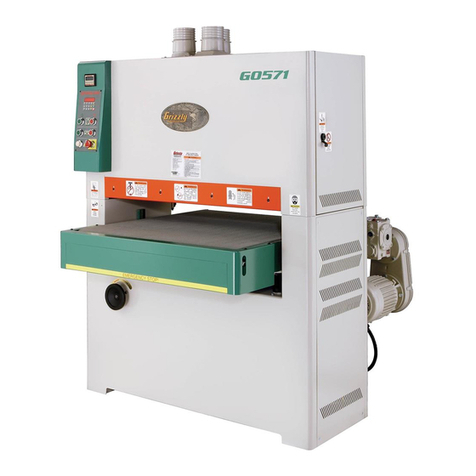
Grizzly
Grizzly G0571 instruction manual
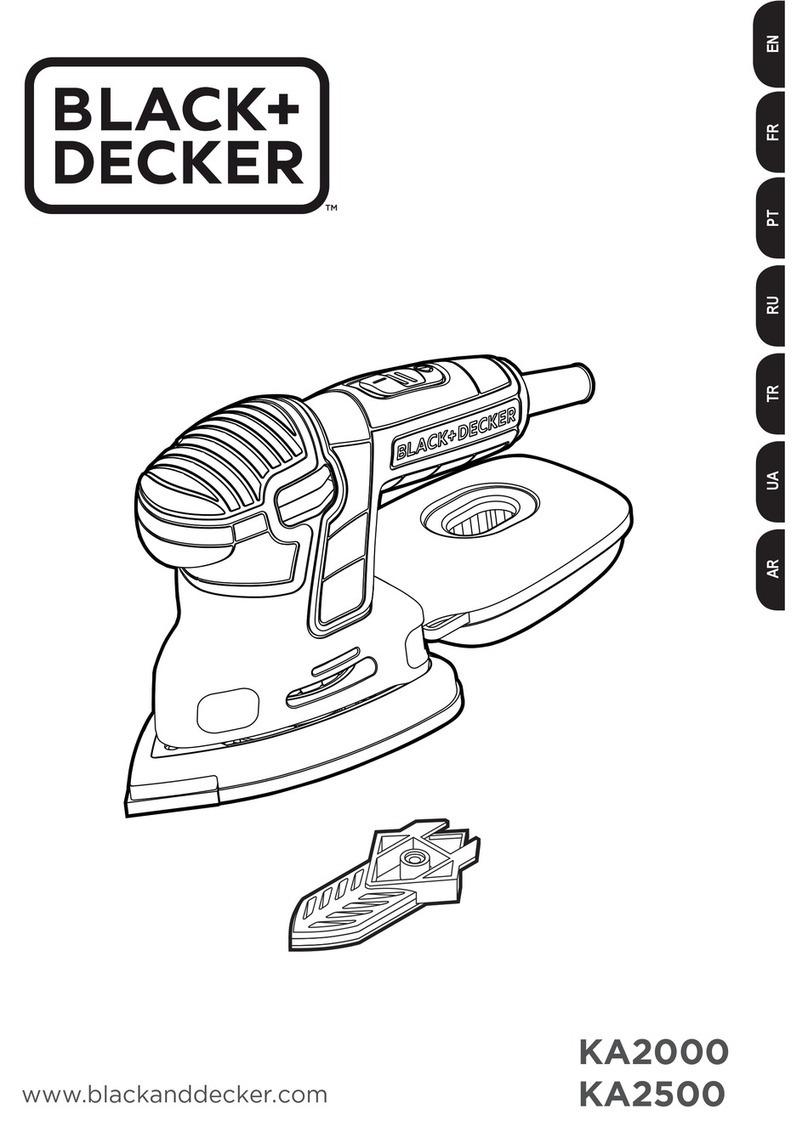
Black & Decker
Black & Decker KA2000 Original instructions
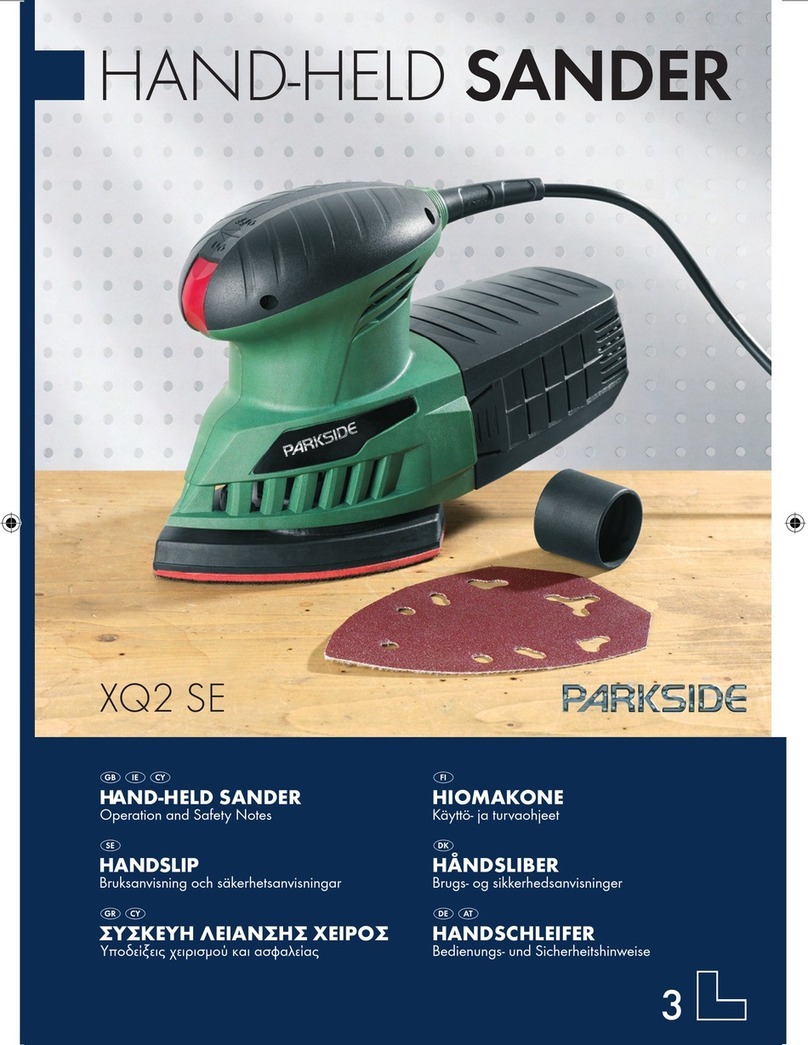
Parkside
Parkside XQ2 SE Operation and safety notes

Clarke
Clarke FM-1500 HD Operator's manual

MIRKA
MIRKA AROP-B 312NV operating instructions

Alpha Professional Tools
Alpha Professional Tools AEP-458 Instructional guide
